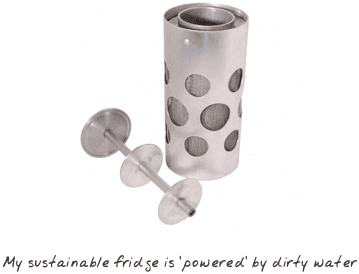
Sustainable refrigerator
We can’t continue to rely on electrical appliances powered by fossil fuels, so I tried to come up with an alternative: a sustainable fridge which is ‘powered’ by dirty water. My prototype consists of two metallic cylinders, one inside the other, between which a locally-sourced material such as sand or wool is packed tightly before being soaked with water. When the fridge is placed in a warm environment, the sun’s energy causes the outer part of the fridge to ’sweat.’ Water evaporates from the sand or wool and heat energy is transferred away from the inner cylinder, which therefore becomes cooler.
The design is ideal for use in the developing world because it doesn’t require electricity and can be built using barrels, spare car parts and ordinary household materials. Unlike previous pot-in-pot coolers, the contents are kept dry and hygienic because the water does not come into contact with the product.

Water carrier
African women and children often walk many miles a day to collect water using only one or two jerry cans, so I designed a carrier that would make their journey easier and more productive.
Up to five containers of water can be held in place using surplus tyre inner tubes. Inspired by the Dyson Ball Barrow, the ‘wheel’ provides maximum stability for the containers and is created using tree branch sections of varying diameter.
Pegs are used instead of glue so that individual components can be renewed as needed. The product can be adapted to carry firewood or other heavy loads and may be completely recycled at the end of its working life.

Toothpaste dispenser
My grandad Wilf couldn't squeeze toothpaste tubes properly because of his arthritis, so I created a dispenser that changed the squeezing action into a pushing one.
The angled back-plate is attached, via a pivot, to a lever that can be pushed by any part of the body. As the lever is depressed it squeezes the tube from the top down, minimising wastage.
The dispenser can be used with a variety of products, by people with limited arm movement or prosthetic limbs and in situations where hygiene is important, such as in hospitals or kitchens.
